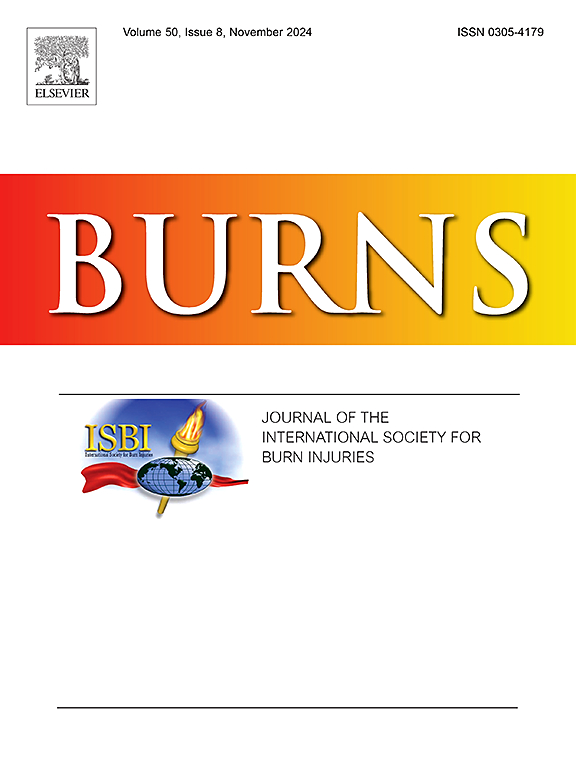Synergistic effects of amniotic membrane and human milk exosomes on burn wound healing
IF 2.9
3区 医学
Q2 CRITICAL CARE MEDICINE
引用次数: 0
Abstract
Background
Thermal burns are one of the most common burns. Studies are ongoing to develop synthetic or biological wound dressings to ensure painless and scarless healing of burn wounds.
Objectives
This study aimed to combine the human amniotic membrane with breast milk-based exosomes and investigate their effects on burn wound healing.
Methods
24 Wistar Albino rats weighing 200–250 g and of both genders were used. Rats were divided into control, burn, burn+human amniotic membrane (hAM) and burn+hAM+Exosomes (hAM+Exo) groups. Burn injury was induced by exposing the back of rats to 90 °C water for 10 s. Rats were treated with hAM and hAM+ Exo for seven days after injury. At the end of the 7th day, the skin samples were taken and analyzed biochemically and histologically. TNF-, IL-1, type III collagen, malondialdehyde (MDA), glutathione (GSH), total protein, superoxide dismutase (SOD), and tissue factor (TF) activity were determined in skin samples.
Results
In the burn group, skin TNF- levels increased, IL-1 and type III collagen levels decreased. Wound healing therapy reversed these results. In the hAM+Exo group, the TNF- level was lower, and IL-1 and type III collagen levels were higher than in the hAM group. MDA and total protein levels increased, and GSH, tissue factor, and SOD activities decreased in the burn group. In hAM and hAM+Exo groups, MDA levels decreased, and GSH and SOD activity increased compared to the burn group. The GSH levels were significantly higher in the hAM+Exo group compared to the hAM group.
Conclusion
In conclusion, combining exosomes and amniotic membrane induced changes consistent with better wound healing than amniotic membrane alone.
羊膜和人乳外泌体对烧伤创面愈合的协同作用
热烧伤是最常见的烧伤之一。目前正在研究开发合成或生物创面敷料,以确保烧伤创面的无痛和无疤痕愈合。目的将人羊膜与母乳外泌体结合,探讨其对烧伤创面愈合的影响。方法选用Wistar Albino大鼠24只,体重200 ~ 250 g,雌雄同体。将大鼠分为对照组、烧伤组、烧伤+人羊膜组(hAM)和烧伤+羊膜+外泌体组(hAM+Exo)。将大鼠背部暴露在90 °C的水中10 s,诱导烧伤。大鼠损伤后用hAM和hAM+ Exo治疗7天。第7天末,取皮肤标本进行生化和组织学分析。测定皮肤样品中TNF-α、IL-1β、III型胶原蛋白、丙二醛(MDA)、谷胱甘肽(GSH)、总蛋白、超氧化物歧化酶(SOD)和组织因子(TF)活性。结果烧伤组大鼠皮肤TNF- α水平升高,IL-1β和III型胶原水平降低。伤口愈合疗法逆转了这些结果。hAM+Exo组TNF- α水平低于hAM组,IL-1β和III型胶原水平高于hAM组。烧伤组MDA和总蛋白水平升高,GSH、组织因子和SOD活性降低。与烧伤组相比,hAM和hAM+Exo组MDA水平降低,GSH和SOD活性升高。与hAM组相比,hAM+Exo组GSH水平显著升高。结论外泌体与羊膜联合使用对伤口愈合的影响优于单独使用羊膜。
本文章由计算机程序翻译,如有差异,请以英文原文为准。
求助全文
约1分钟内获得全文
求助全文
来源期刊

Burns
医学-皮肤病学
CiteScore
4.50
自引率
18.50%
发文量
304
审稿时长
72 days
期刊介绍:
Burns aims to foster the exchange of information among all engaged in preventing and treating the effects of burns. The journal focuses on clinical, scientific and social aspects of these injuries and covers the prevention of the injury, the epidemiology of such injuries and all aspects of treatment including development of new techniques and technologies and verification of existing ones. Regular features include clinical and scientific papers, state of the art reviews and descriptions of burn-care in practice.
Topics covered by Burns include: the effects of smoke on man and animals, their tissues and cells; the responses to and treatment of patients and animals with chemical injuries to the skin; the biological and clinical effects of cold injuries; surgical techniques which are, or may be relevant to the treatment of burned patients during the acute or reconstructive phase following injury; well controlled laboratory studies of the effectiveness of anti-microbial agents on infection and new materials on scarring and healing; inflammatory responses to injury, effectiveness of related agents and other compounds used to modify the physiological and cellular responses to the injury; experimental studies of burns and the outcome of burn wound healing; regenerative medicine concerning the skin.
 求助内容:
求助内容: 应助结果提醒方式:
应助结果提醒方式:


